When travelling, being able to speak the local language really changes your experience. This allows you to fully understand your environment, to create bonds with locals, to negotiate or to avoid scams and problems. This is the reason why we wanted to learn Spanish. As native French, we speak English fluently thanks to our expat life. We decided one of our world tour goal is to improve our Spanish. Indeed we have a school level, vague memories of high school lessons for Nicolas and a little from university for Clémentine.
Our most important tip for learning Spanish
Spend time in a Spanish speaking country! In our experience, the real way to get started and master speaking a language is to be absolutely have to speak it! Our best advice is to travel to Spain, Central America or South America, and avoid the big cities where you might easily come across people speaking English.
Be careful Spanish differs depending on the country you are visiting!
The language differs mainly between Spain and Latin America, but also in between Latin American countries. The pronunciation and accent, vocabulary and usage of the plural second person pronoun (“vosotros” / “ustedes”) are the main differences.
However if you master Spanish of one country you will have no problem to understand and be understood no matter your destination. Just do some research beforehand to avoid small mistakes. If you want to deepen this topic here is an article with examples and a video illustrating the difference in pronunciation.
We think it is beneficial to prepare before your departure! Indeed, the conversation will become fluid faster. In addition, once there, you will learn faster and be able to master the spoken as well as the written language.
Here are 5 techniques to get ready :
1) Watch your TV shows and movies in Spanish (and review your playlist and your bedside book)
Even if you do not understand anything at first! The secret is to keep watching and you will become accustomed to the actors’ accents and expressions. It does not matter if you miss 70% of the conversation, we always understand a little thanks to the context! If possible always add subtitles in Spanish, it works both your audio and visual memory.
We love this advice because it does not require any particular effort and is entertaining. The majority of us watch TV or series on a regular basis, and it is also a way to turn a relaxation time (called procrastination after 3 episodes) into a very useful activity. More reasons not to feel guilty! Finally, it gives you a glimpse of the culture and habits while allowing you to learn slang and less academic expressions.
We love watching in the original language, however, if you have never watched Spanish movies or series and are not comfortable with listening, it’s reassuring to start with a movie or series you know by heart (like Harry Potter or Friends). You can also cheat at the beginning and have the subtitles in French, but it is way less effective!
It is also very useful to review your playlist for songs from the country you want to visit. Finally, if you feel comfortable with audio only you can listen to podcasts or radio broadcasts (though it is more difficult to get context without images).
Our advice to start watching series in Spanish: telenovelas! Telenovela is a television genre, originally produced in various Latin American countries, telling a love story on a dramatic and rarely realistic tone with many chapters and twists. The actors’ game (rich in gestures and dramatic expressions) makes the understanding easier. If you want an introduction to telenovelas, before you get fully into it, we recommend the excellent American series Jane The Virgin.
Our small selection of movies and series
Spanish series
- Las Chicas del Cable (we love the dramatic side, almost like a telenovela, with a strong feminist vibe).
- La Casa de Papel (be careful, this series is difficult to understand because the very technical language).
Mexican series
- La Casa de las Flores (family dramas in Mexico City).
Argentina series
- Los simuladores (we have not watched it yet but it was highly recommended to us).
Mexican movies
- La Jaula de Oro (a very sad movie everyone should watch on Guatemalan teenagers trying to emigrate to the United States).
- Amores Perros
- Zurdo (a movie for the youngest)
This list is still under construction and we will be adding our latest findings! Tell us in comments about your favourite Hispanic movies / series.
Read books in Spanish
The book nerd of the couple, Clémentine, must add this to the article: read in Spanish! However, reading books is more difficult than audiovisual and you can feel very alone in front of three pages of misunderstanding. However, it is also a great way to make your learning evolve. Again we prefer to read in the original language if possible but you can start with an easy book you know by heart (for example the Harry Potter first book). Comic books or children’s books are a good place to start. The satisfaction of switching to adult books and reading them at almost normal speed is really nice.
The secret is not to try to understand each sentence and re-read them constantly. If you do not know three words in a sentence and can not understand the meaning, it does not matter, keep reading and you should have a general idea at the end of the chapter.
If you respect this first technique and listen to music in Spanish on the way to work, watch your evening shows in Spanish and read in Spanish before falling asleep we are sure you will make very fast progress!
2) Participate in language exchange meetups
This is one of our favourite way to learn a language because it allows you to meet people, be sociable (rather than talking to Duolingo) and go out (after spending hours in the couch watching telenovelas) plus it’s free! It is also an opportunity to help another person with their learning of your native language. These exchanges are organised in all cities and surely near you. You can do some research by registering on Meetup or Duolingo Events.
We also encourage you to search for this exchanges during your trip. It is a great way to meet locals and other travelers who want to practice their Spanish. Thanks to a Duolingo exchange we were able to meet with locals for the Día de Muertos festivities in Mexico.
3) Use a grammar textbook and make vocabulary lists
Nowadays, publishers publish very small, practical and light formats textbooks. You can also use a digital version. It is essential, for us, to be able to check every time you have a doubt about a rule or a conjugation. It is this verification process that will make you remembering the rules. You will hear people telling you, “it does not matter when you talk, you do not need to care about the rules” but we do not quite agree. If you do not know how to conjugate a verb, for example, you expose yourself to a risk of misunderstanding. It also means you will never be able to write an email in a professional way.
If your grammar textbook is well done it should be quite easy for you to read 2-3 pages a day to refresh your knowledge. It also help to learn your conjugations every time you have a moment (transport, wait at the restaurant, etc.) or before going to sleep (the best way to learn things).
We also strongly advise to make your own vocabulary lists with the words you had to search on Google or in a dictionary. Unfortunately, a word is often immediately forgotten but if you take the time to write it down and read it regularly (again before you go to bed is the best) it will be remembered.
Use a general language textbook on paper or PDF?
We all bought these textbooks without ever finishing them (quiting at day 5 of “Lean Spanish in 30 days”…). However even if you only read a small part of it is worth it. These textbooks allow you to work grammar, vocabulary, test yourself and practice with exercises. Here are the ones we tested:
- Spanish in 30 days The level is beginner, a little too easy for us but we continued because it helps us to review the basics, we also like the really short lessons.
The textbooks we really recommend are dictionaries for beginners
We greatly appreciate the Lonely Planet phrasebooks. They go straight to the point giving you the essential words for each situation and are very clear and easy to use. In addition, the guides are specific to the country you want to visit! Here are the ones we used in Central America:
We also like the Insight Guides dictionaries, sold with an app to practice further:
4) Use an app (or watch Youtube channels)
Nowadays apps for learning languages are really well-developed. You can practice writing and speaking with at least some listening and even speech for some (if your microphone works properly and you get to speak intelligibly enough before you get upset at your phone). The app keeps track of your progress and sends you notifications to study. And you always have it with you in your pocket unlike your thousand-page textbook.
Apps we use:
- Duolingo an app made like a game to learn languages. You can also add friends and see their progress. The application is free !
- Babbel a site and a very well done app for personalised learning adapted to your needs. The only downside is it is not free.
Finally, you can also subscribe to Youtube channels, we follow the channel Tu escuela de español.
5) Take classes in a language school
You can do it at home before leaving but also directly in the country you visit. This way you will be sure the teachers are native speakers and have a perfect pronunciation. It will probably cost less and is a very good way to make friends and immerse yourself in the local culture. It can also be an easier and comforting way to start a journey you may find intimidating.
We took classes for a week at Spanish Immersion School in Oaxaca, Mexico. During this week we made some really remarkable progress. We chose this school because lessons are privates (it is only you and the teacher). We believe the results are faster this way. The lessons were perfectly adapted to our level and the teachers were able, after the first class, to know our recurring errors and weak points. Another plus, each school day was divided between two teachers with very different styles, which prevented us from getting used to a single interlocutor. We did not feel at all in school. It is possible to choose the classes location, in a park, walking, in the museum, etc. Within the school the environment is idyllic and classes are held in the garden with turtles, birds and a parrot.
The school also offers local cooking classes and salsa dancing, a great way to continue practicing Spanish while learning more about the culture and socialising with other students. Finally, it is possible to go on a excursion and we had the chance to have a private (and free) tour of Monte Albán ruins by one of the very erudite professors. The school also offers to stay in a host family for a complete immersion. If you would love to take classes with this school but you have not planned to travel to Mexico they also offer courses by Skype. Much more than a school, it is a community focusing on Spanish exchange and study.
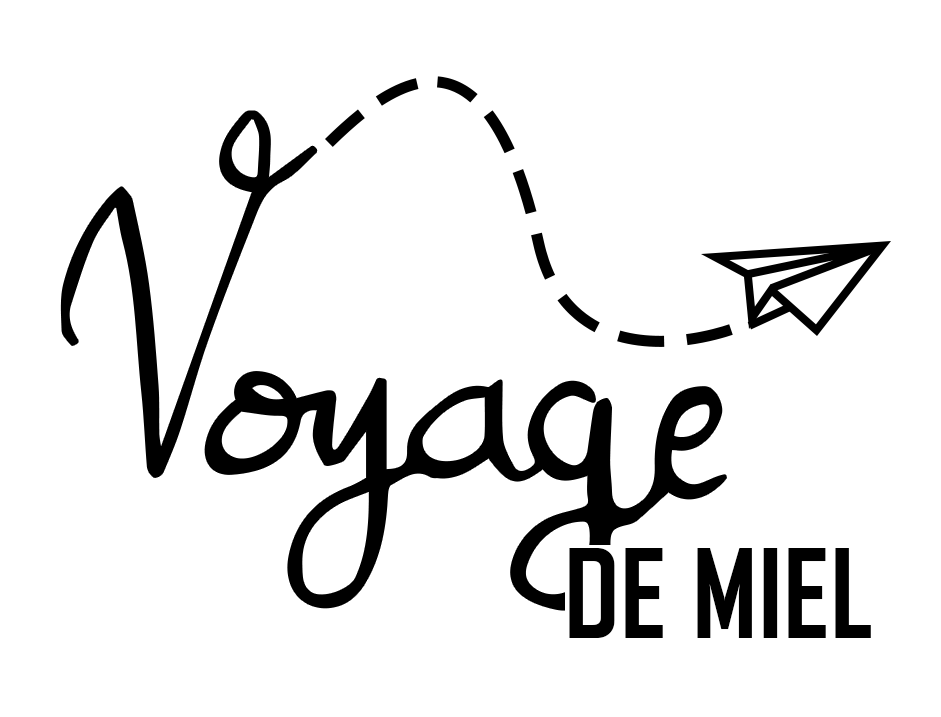
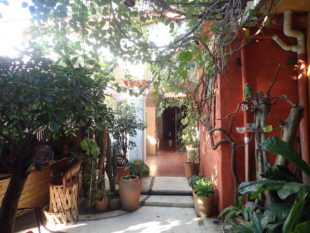
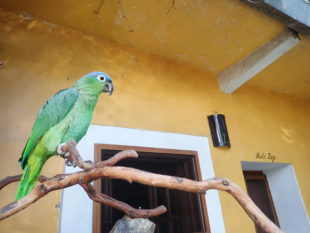
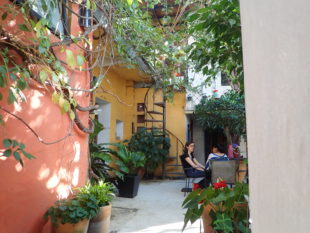
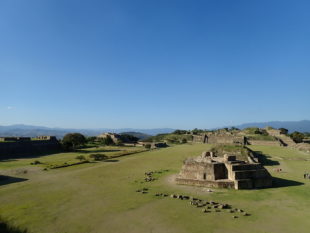
2 Comments